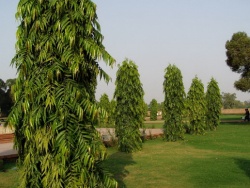Ashoka tree
ashoka tree
阿輸5樹・無憂樹 (Skt; Jpn ashuka-ju or muu-ju ) Saraca asoca (the ashoka tree; lit., "sorrow-less") is a plant belonging to the Caesalpinioideae subfamily of the legume family.[1] It is an important tree in the cultural traditions of the Indian subcontinent and adjacent areas. The ashoka tree is considered sacred throughout the Indian subcontinent, especially in India and Sri Lanka. This tree has many folklorical, religious and literary associations in the region. Highly valued as well for its handsome appearance and the color and abundance of its flowers, the ashoka tree is often found in royal palace compounds and gardens as well as close to temples throughout India.
The ashoka tree is closely associated with the yakshi mythological beings. One of the recurring elements in Indian art, often found at gates of Buddhist and Hindu temples, is the sculpture of a yakshini with her foot on the trunk and her hands holding the branch of a flowering ashoka tree. As an artistic element, often the tree and the yakshi are subject to heavy stylization. Some authors hold that the young girl at the foot of this tree is based on an ancient tree deity related to fertility.
Yakshis under the ashoka tree were also important in early Buddhist monuments as a decorative element and are found in many ancient Buddhist archaeological sites. With the passing of the centuries the yakshi under the ashoka tree became a standard decorative element of Hindu Indian sculpture and was integrated into Indian temple architecture as salabhanjika, because there is often a confusion between the ashoka tree and the sal tree (Shorea robusta) in the ancient literature of the Indian subcontinent.
This tree is also regarded with veneration in Jainism. In the Jain tradition Mahavira is said to have renounced the world under this kind of tree in Vaishali.
In Hinduism the ashoka is considered a sacred tree. Not counting a multitude of local traditions connected to it, the ashoka tree is worshipped in Chaitra, the first month of the Hindu calendar. It is also associated with Kamadeva, the Hindu god of love, who included an ashoka blossom among the five flowers in his quiver. Hence, the ashoka tree is often mentioned in classical Indian religious and amorous poetry, having at least 16 different names in Sanskrit referring to the tree or its flowers.
In Mahākāvya, or Indian epic poetry, the ashoka tree is mentioned in the Ramayana in reference to the Ashoka Vatika (garden of ashoka trees) where Hanuman first meets Sita.
Also, Asoka tree or sorrowless tree. A tall leguminous tree that produces beautiful orange- or scarlet-colored blossoms. It is found in India, Sri Lanka, and other tropical countries, and used as timber. The Sanskrit word ashoka is translated in Chinese as "free from distress," and thus the ashoka tree is often referred to as the sorrowless tree. Tradition has it that, when Maya, Shakyamuni's mother, reached for a branch of this tree to pick its blossoms in the grove at Lumbini, she gave birth to her son. For this reason, in Buddhism the ashoka tree is considered sacred, along with the Bodhi tree under which Shakyamuni attained Enlightenment, and the sal tree representing his entrance into Nirvana. Shakyamuni died in a grove of sal trees.
